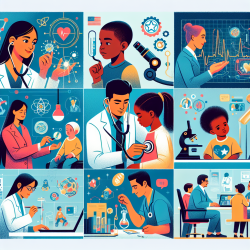Introduction
As speech-language pathologists, understanding how emotional distractions affect cognitive processing in adolescents is crucial for developing effective therapy strategies. The study titled "Distraction by emotion in early adolescence: affective facilitation and interference during the attentional blink" provides valuable insights into how emotionally charged stimuli impact attention in young individuals. This blog will explore the findings and discuss how practitioners can leverage this knowledge to improve therapy outcomes.
Understanding the Study
The research conducted by Heim, Benasich, and Keil (2013) investigates the attentional blink (AB) phenomenon in adolescents aged 10-13 years. Using a rapid serial visual presentation (RSVP) paradigm, the study examined how pleasant, neutral, and unpleasant words as first targets (T1) influenced the identification of subsequent neutral targets (T2) during the AB period.
The findings revealed that pleasant words were more accurately identified compared to neutral and unpleasant words, demonstrating affective facilitation. However, this emotional relevance came at the cost of T2 accuracy, particularly when T1 and T2 were separated by a short interval (232 ms), highlighting the interference effect.
Implications for Practitioners
Understanding these dynamics can significantly enhance therapy approaches. Here are some strategies practitioners can consider:
- Incorporate Emotional Content: Utilize emotionally engaging materials to capture attention and facilitate learning. This can be particularly effective in activities requiring focus and memory retention.
- Manage Emotional Distractions: Teach adolescents strategies to manage emotional distractions. Techniques such as mindfulness and focused breathing can help redirect attention back to the task at hand.
- Balance Emotional and Neutral Stimuli: Use a mix of emotional and neutral stimuli in therapy sessions to prevent overwhelming the cognitive system and ensure sustained attention.
Encouraging Further Research
While this study provides valuable insights, further research is needed to explore the long-term effects of emotional distractions on cognitive development. Practitioners are encouraged to stay informed about new findings and consider participating in research initiatives to contribute to this growing field.
Conclusion
By understanding how emotional distractions impact attention in adolescents, practitioners can tailor their approaches to enhance cognitive processing and learning outcomes. Incorporating these insights into therapy sessions can lead to more effective interventions and better support for young individuals.
To read the original research paper, please follow this link: Distraction by emotion in early adolescence: affective facilitation and interference during the attentional blink.










